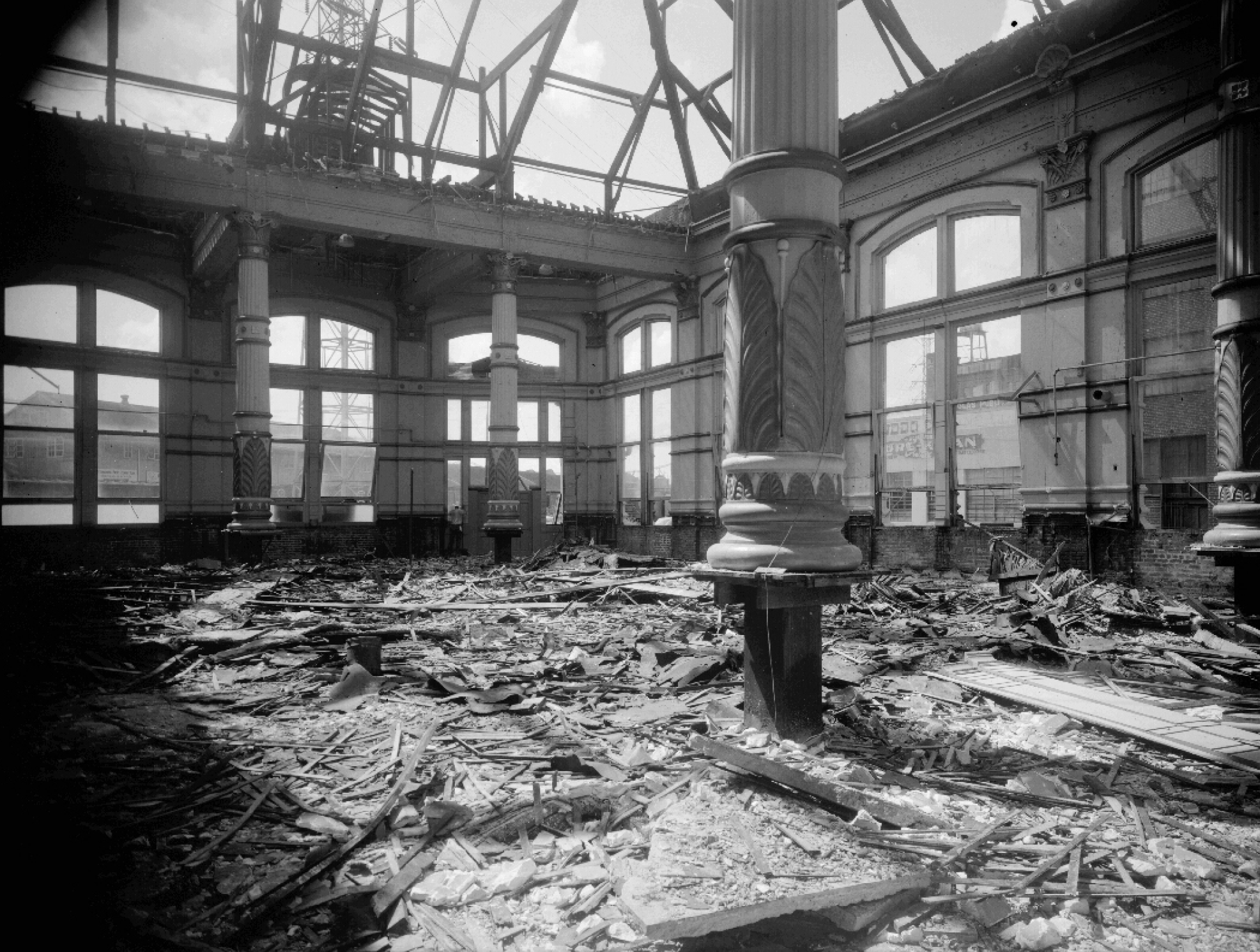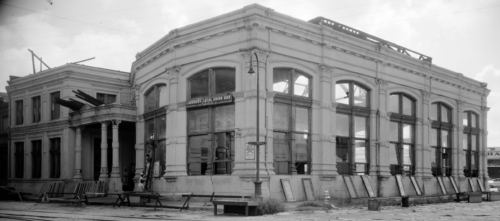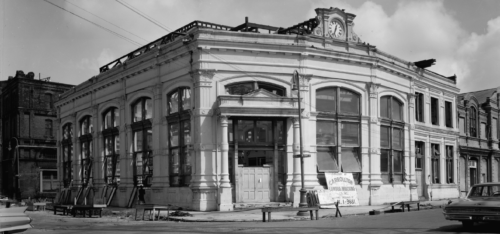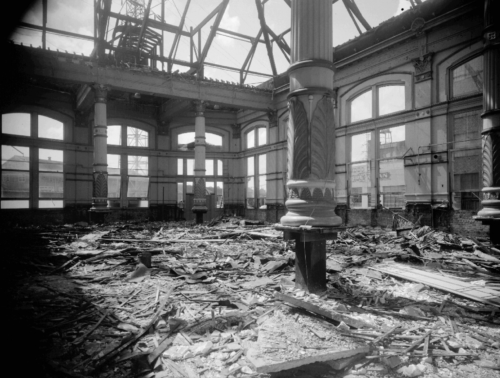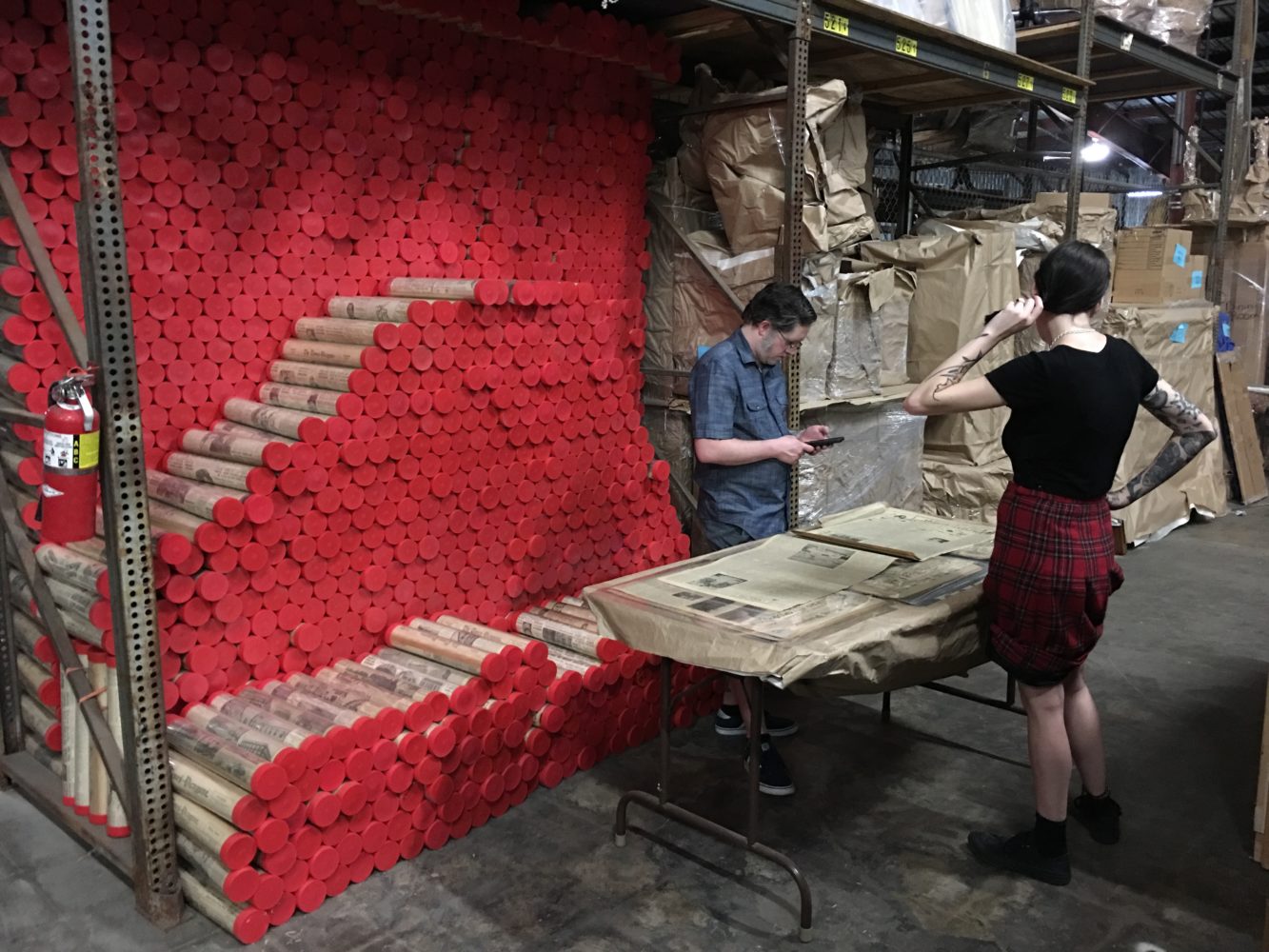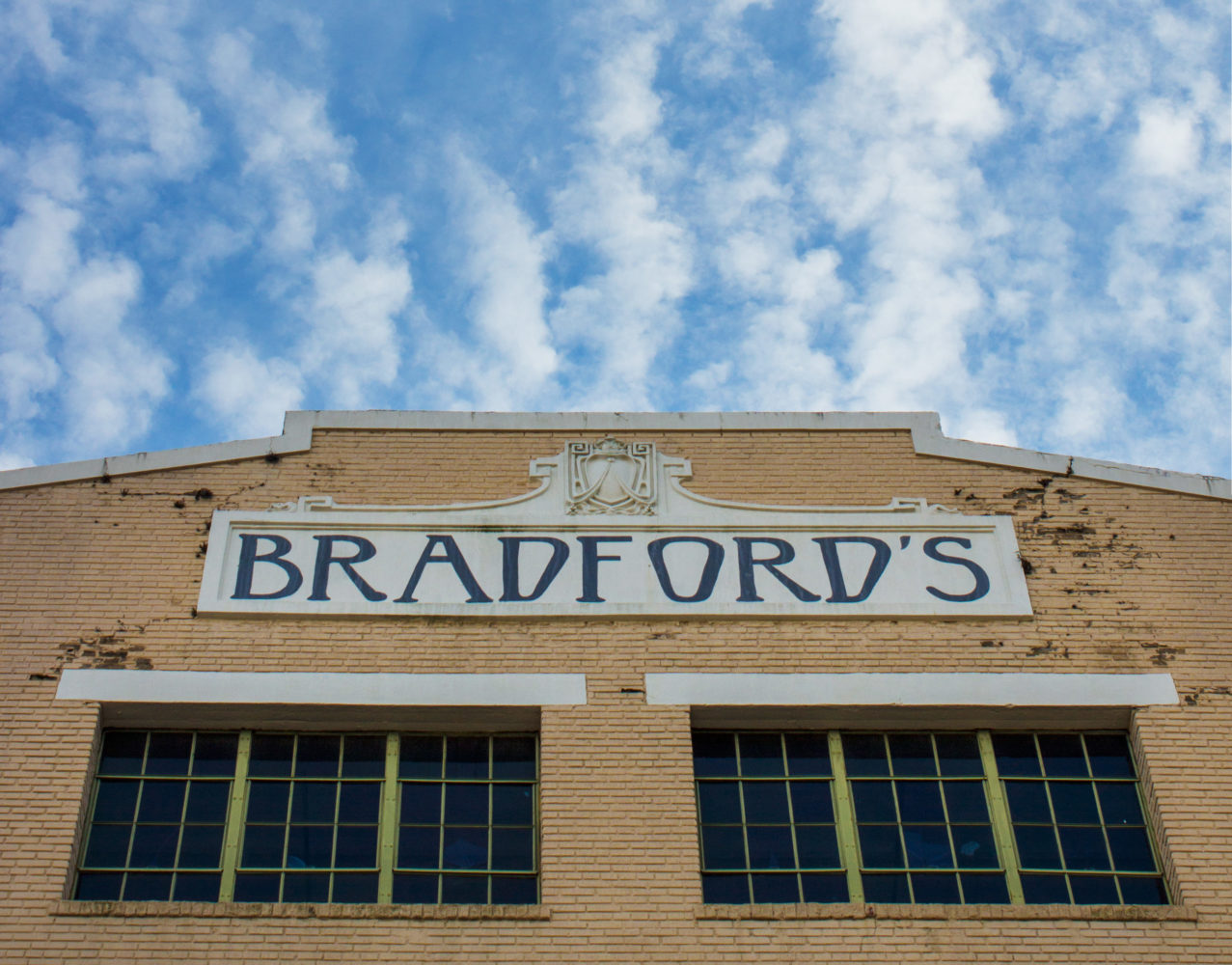This story first appeared in the February issue of the PRC’s Preservation in Print magazine. Interested in getting more preservation stories like this delivered to your door each month? Become a member of the PRC for a subscription!
For nearly 80 years stood, in a French Quarter riverfront area now dominated by parking lots, the central marketplace for two key Louisiana commodities. Known as the Louisiana Sugar and Rice Exchange, the elegant edifice formed the heart of a vital industry district, while the trading inside influenced thousands of Louisianans toiling on hundreds of plantations. Its demolition in 1963 reflected preservationist sensibilities of that era, and how they would later change.
Sugar cane became a chief Louisiana export shortly after planter Jean Etienne de Boré in 1795 successfully replicated protocols for granulating cane juice, which, in this subtropical environment, differed from those practiced in the West Indies. Granulation made sugar dry, light, compact, durable, and therefore exportable, at a time when the slave insurrection in Saint-Domingue drastically reduced sugar exports from that French colony. An opportunity opened for Louisiana planters to seize market share, and they responded by abandoning rice, indigo and tobacco crops in favor of sugar cane cultivation. They would additionally benefit from the 1809 arrival of thousands of refugees from former Saint-Domingue, now Haiti, many of whom had expertise in sugar agronomy and refining technology.
Within a decade of Boré’s breakthrough, over 70 cane sugar plantations lined both banks of the river from present-day Kenner to English Turn. American dominion over Louisiana further spurred sugar expansion, through import tariffs, new production technologies, mounting demand, and ever-expanding levees and drainage projects. But the economic success came at a terrible human cost: so insatiable was the demand for enslaved labor that nearly one million African Americans would be transferred out of the Upper South for sale into in the Lower South, oftentimes through the New Orleans slave market and destined for the Louisiana sugar fields as well as interior cotton plantations.
By 1850, Louisiana produced 105,000 tons throughout the “sugar bowl,” from the lowermost Mississippi River up the Red River to Natchitoches and westward to the Attakapas and Opelousas regions. By 1861, that figure reached 230,000 tons, a hundred-fold increase in two generations, which brought $25 million (well over half a billion today) into the pockets a few thousand planter families and industry handlers. More than half the yield passed through New Orleans, specifically the upper French Quarter, where a vast workforce stewarded the transshipment.
It was the professional end of that workforce that would bring about the Sugar and Rice Exchange as a node for financial transactions. In the early years, such transactions took place on the plantations themselves, but in the interest of finding more merchants and higher bids, planters increasingly took their business to New Orleans. There, they consigned their yield to commission merchants who would interact with wholesalers and buyers at the city’s various “exchanges,” usually coffee house (saloons) associated with hotels.
The New Orleans end of the Louisiana sugar industry got a new geography starting in 1830, when the batture along the upper French Quarter riverfront, between present-day North Peters and the Mississippi, got upgraded with planked wharves, protruding docks and new warehouses. “From this time on,” wrote J. Carlyle Sitterson in his book Sugar Country: The Cane Sugar Industry in the South, 1753-1950, “a regular sugar market with daily transactions operated on the levee.”
Convenient to docking steamboats as well as downtown banks and offices, the refurbished riverfront would develop into the nation’s premier sugar-trading space. The workflow started as planters consigned their sugar and molasses to city factors and shipped their hogsheads bound for the sugar landing. There, clerks boarded the steamboats to identify which cargo were consigned to which brokers, who in turn met with prospective buyers to sample the product and agree on a price. Weighers hauled bulky scales to the scene of deals, while draymen towed hogsheads to waiting vessels or to warehouses. The pace bustled, due to the nature of the business as well as a local ordinance stipulating that produce had to be sold within 36 hours or removed to storage, to keep the levee clear.
Services were costly from the planter’s perspective: the factor received a 2.5 percent commission, and insurance for shipping cost another 1 percent. There were also charges for transportation, cooperage, weighing, tarpaulin, and drayage, plus a monthly charge of 30 to 50 cents per hogshead for warehousing. In all, about 10 percent of gross revenue stayed with Crescent City sugar men, and most of that went to those at the apex of the profession. Splendid mansions standing today throughout historic New Orleans testify to this concentration of wealth.
Louisiana sugar suffered a severe blow during the Civil War. Statewide production dropped 98 percent between 1861 and 1864, and financial losses ran as high as 99 percent by war’s end. Planters saw “their” workforce disappear with emancipation, and scrambled to replace the workers with contract or immigrant labor. With a new tariff against foreign sugar, production slowly climbed to 9000 tons in 1865, 20,000 the next year, and 75,000 in 1870, still well below antebellum levels.
There were other transformation: because sugar processing had become increasingly industrialized, plantation-based sugar mills gave way to centralized modern refineries — a trend furthered by the postbellum growth of railroads, which befitted concentration, and by a shift in taste from raw to refined sugar, which required more specialized processing. It was in this era, 1870s-1890s, that New Orleans’ sugar landing developed into a bona fide Sugar District, with steel-frame refineries, hundred-foot smokestacks, and distinctive steel sheds amid steam trains, steamboats and teams of dockworkers.
Key to the functionality of the Sugar District was its sheds, because sugar had to be stored and kept dry until the best prices could be attained. The warehouses were owned by the New Orleans Sugar Shed Company, a firm reputed to be a corrupt monopoly prone to overcharging and mishandling. Frustration and litigation against the company led members of the Louisiana Sugar Planters’ Association to consider forming their own exchange, where sugar could be sold by sample, and on-site storage would be circumvented. An exchange would also serve as an assembly space where merchants could interact, trade, devise standards, share information, and socialize. Other industries were doing the same thing, among them the New Orleans Cotton Exchange, the Fruit Exchange, and the Mechanics, Dealers and Lumbermen’s Exchange, and each seemed to be prospering.
The Louisiana Sugar Exchange came to fruition at the Association’s meeting in February 1883. Within weeks, the group obtained a state charter, drew up a constitution and by-laws, and elected its officials. In July of that year, four lots at the corner of Bienville and North Front streets were purchased from Pauline Lafarque Blanche for $16,262 plus fees, and noted local architect James Freret won the competition for the structure. His graceful Beaux Arts design featured triptych walls in front and rear, large windows, a landmark clock in the pediment, and a skylight atop a 65-foot-high dome supported by four fluted Ionic columns within the main hall. Most unusual was the main entrance on now-gone Clay Street, which had a canopy-covered doorway in the indentation between the hexagonally shaped main hall on the upper side, and the rectangular office section on the lower side. Joseph R. Tureck erected the structure over the next year, at a cost of $52,000, and a dedication was held on June 3, 1884.
According to a speech delivered at the opening ceremony, the Exchange’s purpose was “to govern and direct how commodities [are] sold, purchased, and delivered; to fix penalties for failure to comply with contracts…; to establish standards of articles bought and sold, [and] to establish rules for…inspectors, weighers and gaugers.” The project was a success, and five years later, the exchange expanded to handle rice, after which it became known as the Louisiana Sugar and Rice Exchange.
The new century brought both regional and national changes to the sugar industry, and it would not bode well for New Orleans’ sugar district. For one, big new refineries were built in rural Chalmette and Grammercy, unfettered by inner-city congestion, and they would draw away most of the raw sugar cane previously destined the French Quarter riverfront. During the 1910s-1920s, blights of mosaic disease and root rot, coupled with consistently bad weather, led to a series of weak harvests. World war, changes on tariffs to foreign imports, rising competition from Western sugar beets, and other political and economic uncertainties took their tool, and by the 1920s, New Orleans’ sugar industry found itself in steep decline.
Government price supports, meanwhile, took the speculative edge out of the trading activity at the Sugar and Rice Exchange. Louisiana’s share of the national sugar market fell from 11 percent in 1900 to only 4.5 percent in 1937. By then, most local brokers, factors, and sugar and molasses firms had closed down. In 1941, the Louisiana Sugar and Rice Exchange sold its ornate building to the Construction and General Laborers for $13,520, after which it was operated as a meeting hall for the Laborers Local Union 689.
The French Quarter by this time enjoyed historical protection, courtesy the Vieux Carré Commission (1937). Yet public interest in preserving old buildings, limited as it was in this era, largely fell on colonial and antebellum structures of architectural significance. Sugar District buildings, on the other hand, were postbellum and industrial, neither of which appealed to most people’s romanticized notion of the past. Many old sugar buildings were razed before 1937, and those that remained went unappreciated.
In 1946, an ordinance excluded all blocks bounded by Iberville, Decatur, St. Peter, and the river from Vieux Carré Commission jurisdiction, which opened the door to further demolitions. Eighteen years later, the State Supreme Court nullified that ordinance and returned the area to Commission control, but it came one year too late: in the autumn of 1963, the Louisiana Sugar and Rice Exchange Building, by then in ruinous condition, was sold and promptly demolished. It’s been a parking lot ever since.
Had appreciation for historical architecture been more broadly construed in that era, we’d have a very different upper Quarter riverfront today. It would look more like the Warehouse District than a parking district, and the Sugar and Rice Exchange might have become iconic. The loss makes one ponder what elements of the built environment we dismiss today as mundane and worthy of removal, and which of those we might someday come to regret.
A view inside the Louisiana Sugar and Rice Exchange building prior to its 1963 demolition. Photo courtesy Library of Congress.



